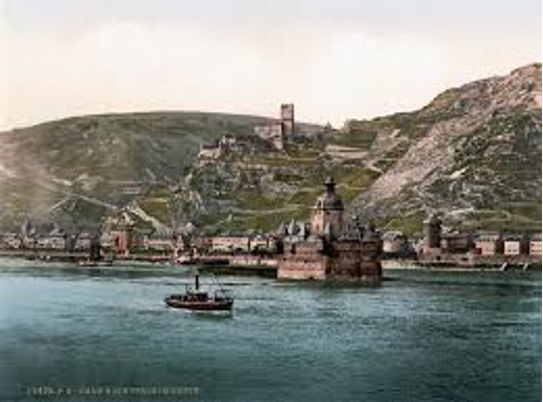Spirit's greeting
(Poet's title: Geistes-Gruß)
Set by Schubert:
D 142
[March 1816]
Part of Goethe: The April 1816 collection sent to Goethe
Hoch auf dem alten Turme steht
Des Helden edler Geist,
Der, wie das Schiff vorübergeht,
Es wohl zu fahren heißt.
“Sieh, diese Senne war so stark,
Dies Herz so fest und wild,
Die Knochen voll von Rittermark,
Der Becher angefüllt;
Mein halbes Leben stürmt’ ich fort,
Verdehnt’ die Hälft’ in Ruh,
Und du, du Menschenschifflein dort,
Fahr immer, immer zu.”
High on the old tower stands
The noble spirit of a hero,
Who, seeing a ship go past,
Wishes it bon voyage.
“Look, these sinews used to be so strong,
This heart so firm and fierce,
These bones were full of knightly marrow,
My beaker was filled to the brim;
I spent half of my life storming off
And the other half stretching out and resting,
And you, you little human ship there,
Keep going, keep on going!”
All translations into English that appear on this website, unless otherwise stated, are by Malcolm Wren. You are free to use them on condition that you acknowledge Malcolm Wren as the translator and schubertsong.uk as the source. Unless otherwise stated, the comments and essays that appear after the texts and translations are by Malcolm Wren and are © Copyright.
☙
Themes and images in this text:
Boats Bones and skeletons By water – river banks Castles and towers Cups and goblets Emptiness and fullness Ghosts and spirits Hearts High, low and deep Journeys On the water – rowing and sailing Rest Storms
There were spots of rain on the morning of Monday, 18th July 1774 when the boat set off for Koblenz from Bad Ems. On board was a group of a dozen or so men, including the educational reformer and liberal theologian Johann Bernhard Basedow (1723 – 1790) and the physiognomist Johann Caspar Lavater (1741 – 1801), whose diary records the details of the trip. There was lively conversation about Basedow’s new school (the Philanthropinum), based on the principle of encouraging natural curiosity and sympathy (e.g. by using role play and discouraging rote learning). A few people said that they would happily be pupils there if only they weren’t already grown up. Goethe, who had been writing a list of rhyming words, contributed a couplet:
Wir werden nun recht gut geführt
Weil Baßedow das Ruder rührt.
We are going to be led really well
Because Basedow is at the helm.
As Lahneck Castle came into view and the boat approached the confluence with the Rhine, Goethe then dictated the ballad Geistes-Gruß, bringing together the conversation about education and the dramatically Romantic setting of the old castle.
Looking up to the fortifications towering above us, we, passengers on the boat of humanity, are greeted by the ghost of one of the castle’s former owners or occupants. He wishes us well on our journey but his words are not exactly reassuring. Although he recalls only the positive aspects of his old life in the castle when his sinews were strong, his bones were rich in marrow and his cup was brimming over, we cannot help but think of what is unspoken. His body has decomposed, his beaker is empty, he is no longer in a position to storm out and attack passing boats to demand tribute or taxes.
We are therefore allowed to pass. Our little ship is about to leave the Lahn and be buffetted by the famously treacherous waters of the Rhine. Are we really going to ‘keep going’, as the voice suggests? Where are we on our journey? Have we just set out and do we need someone like Basedow to steer our course or have we passed that point? Are matters in our hands now? Is the mouth of the Lahn the beginning or the end? What is the spirit of the old hero of Lahneck Castle really saying?


☙
Original Spelling Geistes-Gruß Hoch auf dem alten Thurme steht Des Helden edler Geist, Der, wie das Schiff vorüber geht, Es wohl zu fahren heißt. "Sieh, diese Senne war so stark, Dies Herz so fest und wild, Die Knochen voll von Rittermark, Der Becher angefüllt; "Mein halbes Leben stürmt' ich fort, Verdehnt' die Hälft' in Ruh, Und du, du Menschen-Schifflein dort, Fahr' immer, immer zu!"
Confirmed by Peter Rastl with Schubert’s source, Goethe’s sämmtliche Schriften. Siebenter Band. / Gedichte von Goethe. Erster Theil. Lyrische Gedichte. Wien, 1810. Verlegt bey Anton Strauß. In Commission bey Geistinger. page 85; with Goethe’s Werke, Vollständige Ausgabe letzter Hand, Erster Band, Stuttgart und Tübingen, in der J.G.Cottaschen Buchhandlung, 1827, page 106, and with Goethe’s Schriften, Achter Band, Leipzig, bey Georg Joachim Göschen, 1789, page 149.
To see an early edition of this text, go to page 85 [99 von 418] here: http://digital.onb.ac.at/OnbViewer/viewer.faces?doc=ABO_%2BZ163965701


